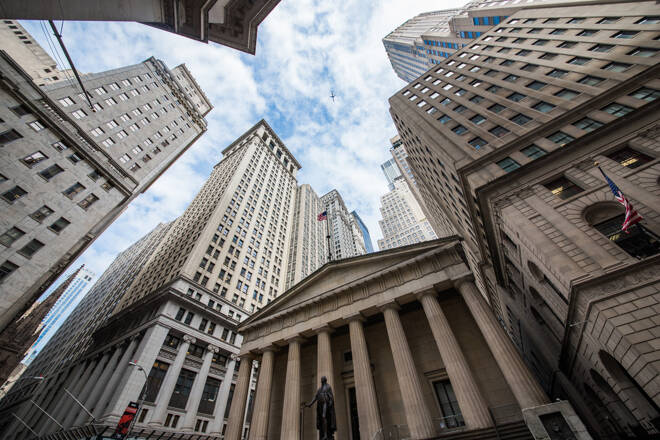Advertisement
Advertisement
Gap Q2 Comparable Sales Jump 13% as Online Shopping Nearly Doubled Amid COVID-19 Crisis; Target Price $24
By:
Gap Inc, an American worldwide clothing and accessories retailer, reported a 13% increase in comparable sales in the second quarter, largely driven by a 95% surge in online buying amid COVID-19 pandemic, sending its shares up over 2% on Thursday.
Gap Inc, an American worldwide clothing and accessories retailer, reported a 13% increase in comparable sales in the second quarter, largely driven by a 95% surge in online buying amid COVID-19 pandemic, sending its shares up over 2% on Thursday.
The San Francisco-based retailer reported a second-quarter net loss of $62 million, or 17 cents per share, compared to a profit of $168 million, or 44 cents per share, a year earlier. Net sales declined about 18% to $3.28 billion but were above market consensus of $2.91 billion.
“Gap (GPS) is benefiting from the shift in consumer demand toward comfort and casual and impressively increasing its online sales penetration across brands. We believe Old Navy’s authority in the value space and Athleta’s compelling brand positioning in athleisure are resonating with consumers in the current environment and should serve as near-term tailwinds. However, we view Back to School shopping could be both lower and more extended, and we are more cautious than optimistic about holiday sales prospects. Key factors we monitor include: the promotional environment during the holiday season, the possibility of additional store closures, and higher fulfilment costs,” said Oliver Chen, equity analyst at Cowen.
“From a valuation perspective, the stock has rebounded 220% from its low point in March driven by the Yeezy announcement and higher conviction around Athleta and e-commerce sales. Given the stock run, we think the stock upside is limited in the near-term. We view GPS should trade close to the 3-year average FY2 P/E multiple of 11x, and we update our price target to $15 based on our updated FY2 EPS estimate,” Chen added.
The company delivered positive operating income and improved its cash balance by over $1 billion compared to the first quarter, ending the quarter with a cash and cash equivalents balance of $2.2 billion.
The second-quarter fiscal year 2020 comparable sales were up 13%, driven by the strength of Gap Inc.’s scaled e-commerce business, which added over 3.5 million new customers during the quarter. The comparable sales calculation reflects online sales and comparable sales days in stores that have reopened.
Given the high level of uncertainty amid ongoing COVID-19 pandemic, Gap did not provide fiscal year net sales or earnings forecast.
On Thursday, Gap shares closed 2.05% higher at $17.38, the stock is down about 2% so far this year.
Executives’ comments
“We nearly doubled our e-commerce business, with approximately 50% online penetration, demonstrating our ability to pivot to a digitally-led culture,” said Sonia Syngal, Chief Executive Officer, Gap Inc.
“Our strong financial position, healthy cash flow generation and our continued execution of initiatives to drive profitable growth provide the foundation to emerge from the crisis well-positioned to compete in a rapidly evolving marketplace,” said Katrina O’Connell, Chief Financial Officer, Gap Inc.
“Recognizing the uncertainty ahead, we remain committed to amplifying our distinct advantages and leveraging our scale to capture share as demand recovers,” O’Connell added.
Gap stock forecast
Citigroup upgraded Gap from a “neutral” rating to a “buy” rating and raised their price target to $24 from $12. Gap had its target price raised by analysts at RBC to $21 from $18.
Other equity analysts also recently updated their stock outlook. Morgan Stanley gave a target price of $11 with a high of $19 under a bull-case scenario and $3 under the worst-case scenario. Cowen and Company raised their target price to $15 from $11, B Riley FBR upped their price objective to $15 from $10 and JP Morgan establishes December 2021 price target of $16 from $14 for December 2020.
On the other hand, fourteen analysts forecast the average price in 12 months at $14.33 with a high forecast of $24.00 and a low forecast of $8.00. The average price target represents a -17.55% decrease from the last price of $17.38. From those 14 analysts, three rated “Buy”, nine rated “Hold” and two rated “Sell”, according to Tipranks.
We think it is good to buy at the current level and target $24 as 50-day Moving Average and 50-200-day MACD Oscillator signals a strong buying opportunity.
Analyst view
“Gap (GPS) is in need of significant transformation. However, we are more positive on the LT forecast given mgmt’s commitment to fleet and corporate downsizing. The separation work and COVID-19 may be the catalysts GPS needed to downsize its business. Our fundamental concerns remain (falling store traffic, eComm disintermediation, declining brand health, apparel price deflation, falling margins), but are exacerbated in the NT driven by the COVID-19 impact,” said Simeon Gutman, equity analyst at Morgan Stanley.
“We think GPS’ value proposition is potentially no longer competitive, as Gap and BR have lost relevance with consumers; ON and Athleta are relative bright spots. We see a limited capacity for share buybacks, dividends, and SG&A savings in 2020-2021,” Gutman added.
Upside and Downside risks
Upside: 1) Segment comp outperformance (particularly at Gap/BR). 2) Successful revised strategy/execution under a new CEO. 3) Limited CECL impact to credit profit share. 4) Better-than-feared COVID-19 impact / potential recession – highlighted by Morgan Stanley.
Downside: 1) Ongoing Gap brand, BR, and ON performance deterioration. 2) Fashion mis-execution/risk. 3) Competitive risk (particularly at Gap/BR). 4) Worse-than-feared COVID-19 impact / potential recession.
About the Author
Vivek Kumarauthor
Vivek completed his education from the University of Mumbai in Economics and possesses stronghold in writing on stocks, commodities, foreign exchange, and bonds.
Advertisement
